CHAPTER THREE
CLASSIFICATION
3.1Classification of Diatoms
The way the classification is placed here, is as the species are currently understood and placed into their various divisions, classes, orders, families, genera, and species.
Diatoms are Eukaryotic and belong to the Kingdom Protista. They further belong to the super group Chromalveolata and are grouped into the Stremenopiles as the lineage Diatoms. They then form two divisions, Bacillariophyta and Chrysophyta. Next, they are divided into 2 orders in each division. This is followed by several suborders under each order, which is followed by numerous families and subfamilies before they are grouped into genera and species.
Diatoms are commonly divided into two orders on the basis of symmetry and shape: symmetry of the cell and orientation of the secondary structures (markings) on the valve surface. The round centric non-motile Centrales have radial markings while the elongate Pennales, with a gliding motion, have bilateral or linear markings. Diatoms are therefore organized into the different orders, if they are Pennales (bilateral or linear symmetry) or Centrales (radial symmetry).
Other ways in which these two categories differ are:
Centric diatoms are non-motile whereas many pennate forms exhibit a gliding movement which to some extent is dependent on the presence of the raphe.
Sexual reproduction of the Centrales (centric forms) is oogamous whereas that of the Pennales (pennate species) is generally isogamous.
Although species of the two groups sometimes inhabit the same regions, Centrales are more commonly planktonic and marine while Pennales are usually freshwater and usually occur as epiphytes and is components of mud and soil flora.
They are further divided into their suborders and families by other features of their frustules (pores, spikes, etc.) and by their environment (aquatic, terrestrial, arctic, tropical, etc.) (Whittaker and Margulis, 1978).
Domain: Eukarya
Kingdom: Protista
Division: Bacillariophyta
Class: Diatomatae
Order: Centrales
Suborder: Discineae
Family: Coscinodiscaceae
Family: Actnodiscaceae
Family: Eupodiscaceae
Suborder: Soleniineae
Family: Soleniaceae
Suborder: Biddulphiineae
Family: Chaetoceraceae
Family: Biddulphiaceae
Family: Anaulaceae
Family: Euodiaceae
Order: Pennales
Suborder: Araphidineae
Family: Fragilariaceae
Suborder: Raphidiodineae
Family: Eunotiaceae
Suborder: Monoraphidineae
Family: Achnanthaceae
Suborder: Biraphidineae
Family: Naviculaceae
Family: Epthemiaceae
Family: Nitzschiaceae
Family: Surirellaceae
Division: Chrysophyta
Class: Bacillariophyceae
Order: Bacillariales
Suborder: Coscinodiscineae
Family: Cosinodiscaceae
Family: Hemidiscaceae
Family: Actinodicaceae
Suborder: Aulacodiscineae
Family: Eupodiscaceae
Suborder: Auliscineae
Family: Auliscaceae
Suborder: Biddulphineae
Family: Biddulphiaceae
Family: Anaulaceae
Family: Chaetoceraceae
Suborder: Rhizosoleniineae
Family: Bacteriastraceae
Family: Leptocylindraceae
Family: Corethranaceae
Family: Rhizosoleniaceae
Suborder: Fragilariineae
Family: Fragilariaceae
Suborder: Eunotiineae
Family: Eunotiaceae
Suborder: Achnanthineae
Family: Achnanthaceae
Suborder: Naviculineae
Family: Naviculaceae
Family: Auriculaceae
Family: Gomphonemaceae
Family: Cymbellaceae
Family: Epithemiaceae
Family: Bacillariaceae
Suborder: Surirellineae
Family: Surirellaceae
Order: Centrales
Suborder: Coscinodiscineae
Family: Melosiraceae
Family: Thalassiosiraceae
Family: Coscinodiscaceae
Family: Asterolampraceae
Family: Heliopeltaceae
Family: Strictodicaceae
Family: Hemidiscaceae
Suborder: Rhizosoleniineae
Family: Pyxillaxeae
Family: Rhizosoleniaceae
Family: Chaetoceraceae
Suborder: Bidulphiineae
Family: Hemiaulaceae
Family: Biddulphiaceae
Family: Eupodiscaceae
3.2Classes and Orders
3.2.1Outline
For many years the diatoms - treated either as a class (Bacillariophyceae) or a division (Bacillariophyta)—were divided into just 2 orders, corresponding to the centric and the pennate diatoms (Centrales and Pennales). This classification was extensively overhauled by Round, et al (1990) who treated the diatoms at a higher rank (division, corresponding to phylum in zoological classification. Today as of 2022, it is recognized that the 1990 system of Round et al. needs revision with the advent of molecular work, and current systems in widespread use such as Diatom Base.
Figure 1: A Schematic Representation of Pennate and Centre Diatom Exposing the Structural Detail (Culled from Diatom Wikipedia)
Figure 1: A Schematic Representation of Pennate and Centre Diatom Exposing the Structural Detail (Culled from Diatom Wikipedia)
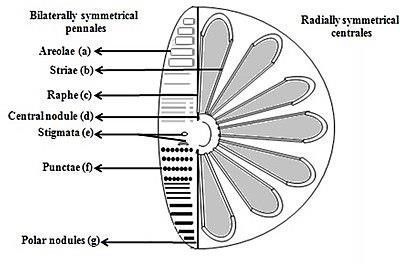
3.3Order Centrales
Diatoms with this form of radial symmetry (Centrales) live in the sea, as one of the plankton constituents. To make it easy to float in the water, there are floating tools, which are thorns or wings, or with intermediate lenders. For sexual breeding, a vegetative cell conducts a reduction division to form four haploid nuclei. Three of them perished, leaving only one nucleus to be the egg core and the whole cell is now an oogonium.
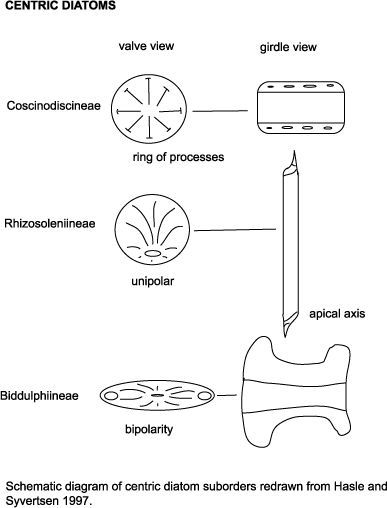
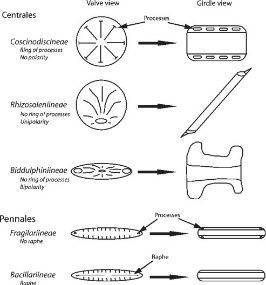

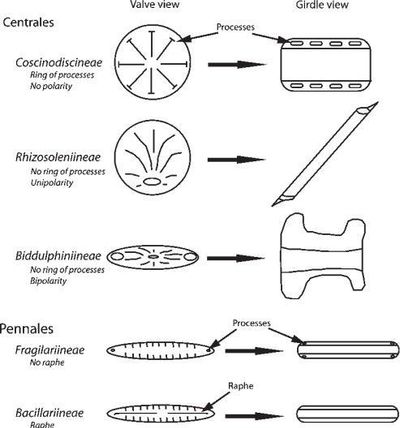
Figure 2: Schematic Diagram of Centri and Pennate Diagram Suborders (Redrawn from Hasle & Syversten, 1997)
3.4Order Pennnales
Diatoms that have a body of bilateral symmetry (Pennales) are usually attached to the aquatic plants. Sexual proliferation takes place by isogamy. Two vegetative cells, removing pectin and mucilage, each having a reduction division, and forming 4 haploid nuclei. Two gametes each with 2 nuclei, out of which one causes fusion, while the other degenerates.
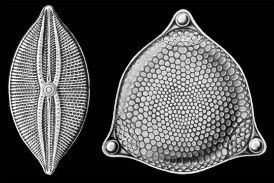

(a)
(b)
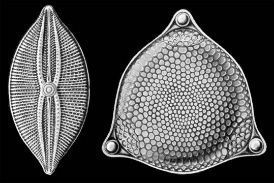
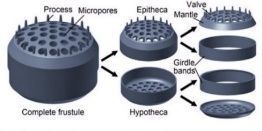
(a)
(b)
Figure 3: Diagrammatic representation of (a) Pennate & Centric diatom spp. (b) Structure of a centric diatom frustule components (Culled from Diatom Wikipedia).
Figure 3: Diagrammatic representation of (a) Pennate & Centric diatom spp. (b) Structure of a centric diatom frustule components (Culled from Diatom Wikipedia).